Tom's Hardware Verdict
Crucial’s latest X10 portable SSD is faster and roomier than its predecessors, with 6TB and 8TB options, but its USB 3.2 Gen 2x2 interface feels dated now that USB4 is faster and more common.
Pros
- +
Available in 1, 2, 4, 6, and 8TB capacities
- +
Fast for a 20 Gbps drive
- +
Compact and pocket-friendly
Cons
- -
Feels like it should be a USB4 drive
Why you can trust Tom's Hardware
Back in mid-2023, Crucial launched the X10 Pro, a tiny, slim USB 3.2 Gen 2x2 (20 Gbps) portable SSD with a black metal lid and enough performance and value to earn a spot on our best external SSDs page. Now Crucial is back with the X10, a drive that drops the Pro epithet and swaps the metal lid for a blue plastic shell that still manages to feel very solid.
The X10 also stands out for its plethora of capacities: 1, 2, 4, 6, and 8TB. Crucial sent us the 4TB model for testing, but the 6TB option is an unusual capacity that could fill a particular niche. Strangely though, the 6TB drive was selling for more than the 8TB model on Amazon when we wrote this.
As we’ll see in testing, the Crucial X10 bests its older sibling and most other 20 Gbps drives on performance and value. But here in mid-2025, USB 3.2 Gen 2x2 drives feel more niche than ever now that USB4 ports have become more popular. USB4 drives like Corsair’s EX400U can deliver as much as twice the speed and don’t cost much more at some capacities.
Crucial X10 (4TB) Specifications
Product | 1 TB | 2 TB | 4 TB | 6TB | 8TB |
Pricing | $99 | $162 | $246 | $558 | $439 |
Interface / Protocol | USB 3.1 Gen2 2x2 | USB 3.1 Gen2 2x2 | USB 3.1 Gen2 2x2 | USB 3.1 Gen2 2x2 | USB 3.1 Gen2 2x2 |
Included | 9-inch UBC-C cable | 9-inch UBC-C cable | 9-inch UBC-C cable | 9-inch UBC-C cable | 9-inch UBC-C cable |
Sequential Read | Up to 2,100 MB/s | Up to 2,100 MB/s | Up to 2,100 MB/s | Up to 2,100 MB/s | Up to 2,100 MB/s |
Sequential Write | N/A | N/A | N/A | N/A | N/A |
Dimensions | 2.53 x 1.93 x 0.37 inches | 2.53 x 1.93 x 0.37 inches | 2.53 x 1.93 x 0.37 inches | 2.53 x 1.93 x 0.37 inches | 2.53 x 1.93 x 0.37 inches |
Weight | 37.9 grams | 37.9 grams | 37.9 grams | 37.9 grams | 37.9 grams |
Warranty | 3 years | 3 years | 3 years | 3 years | 3 years |
Design and accessories

At roughly 2.5 x 2 inches and just over a third of an inch thick, Crucial’s X10 maintains the dimensions of the previous-gen X9 and X10 Pro, but it ditches a few grams (not that you’d notice) by switching from a metal top and sides to a plastic blue shell that leans more toward gray when not under photography lights. The design remains one of the smallest and most pocket-friendly options around, which is all the more impressive now that the company offers the X10 in up to 8TB capacities.
The included cable is a little over 9 inches long, but feels a bit short to me because the actual flexible parts of the cable are only about 6.5 inches long. The USB-C plugs and stiff housing make up the rest of the length. Personally, I prefer cables that are about a foot long – especially since most of the fast ports, at least on desktops, are found around the back of the PC.
Comparison products
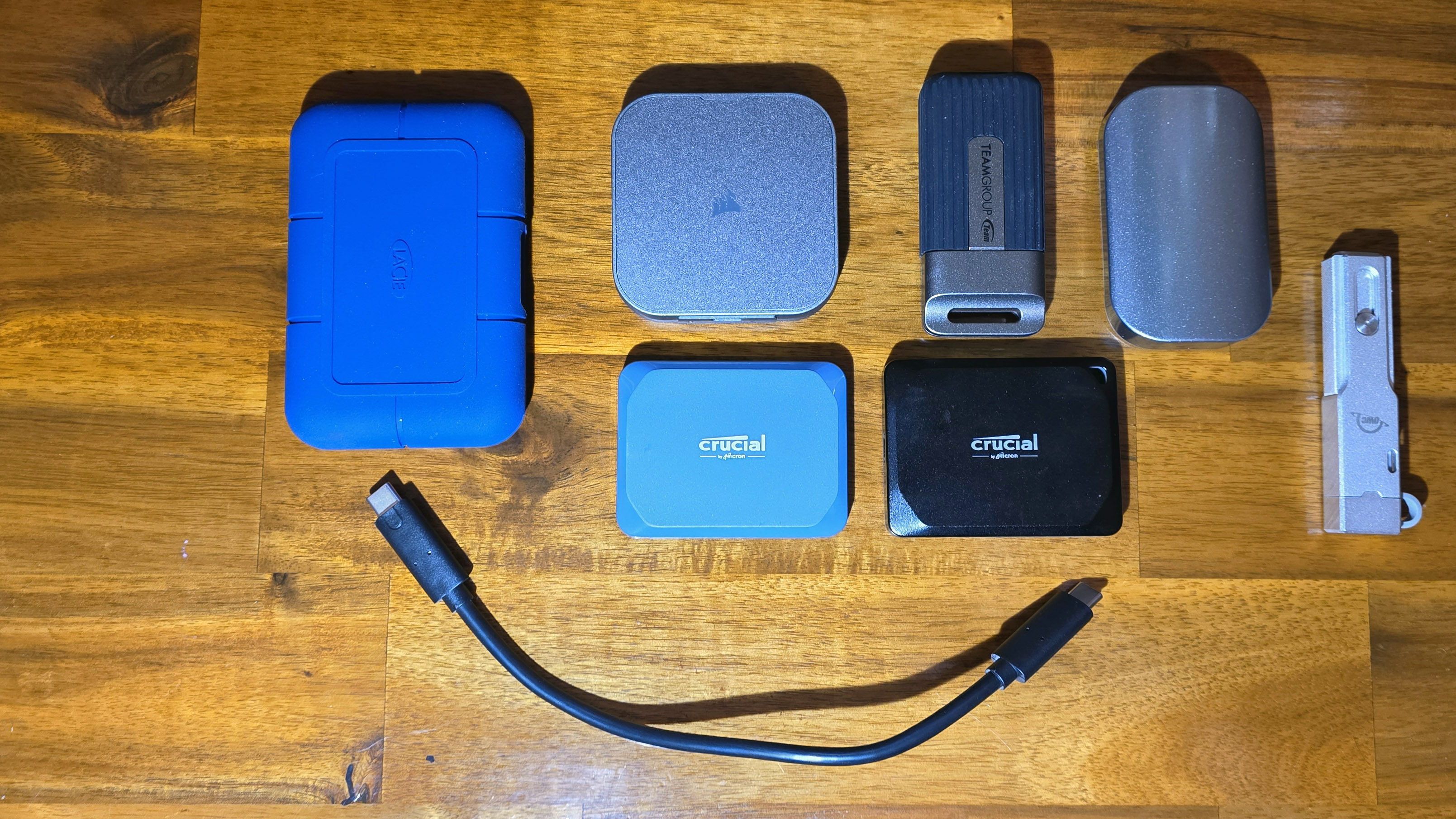
In terms of performance in the 20 Gbps category, Lexar’s Professional SL600 is arguably the X10’s closest competitor in our charts below. The real problem for the X10, though, is that Crucial’s 40 Gbps EX400U doesn’t cost much more (at least at the lower capacities) while being a much faster drive in most respects (provided you have a USB4 port). Both the Lexar and Corsair are considerably larger, though. So if you need something speedy and tiny, Crucial’s X10 still looks good.
Storage testbed update
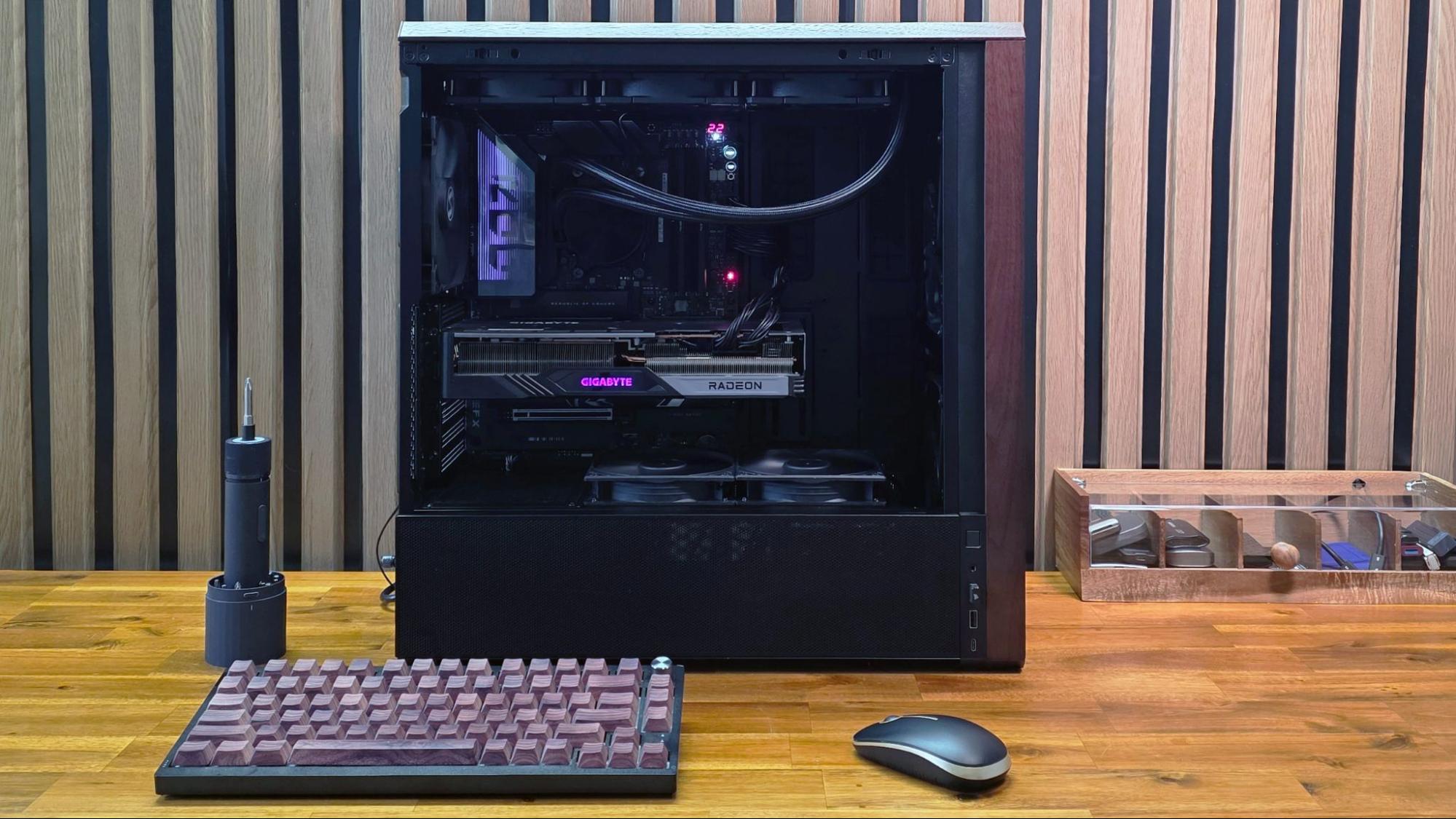
Earlier in 2025, we updated our external storage testbed to an AMD Ryzen 7600X-based PC with an Asus ROG Crosshair X870E Hero motherboard, installed in Lian Li’s Lancool 217 case. This was done in part because we needed a system with native USB4 support for upcoming drives.
All the drives in the charts below have been re-tested on the new X870E system, with the exception of the final Iometer sustained sequential test, which is less about top speed and more about how long a drive can write before depleting any fast cache. We also updated to CrystalDiskMark 8, rather than the older (and non-comparable) version 7 we used on the previous testbed.
Trace Testing - PCMark 10 Storage Benchmark
PCMark 10 is a trace-based benchmark that uses a wide-ranging set of real-world traces from popular applications and everyday tasks to measure the performance of storage devices.
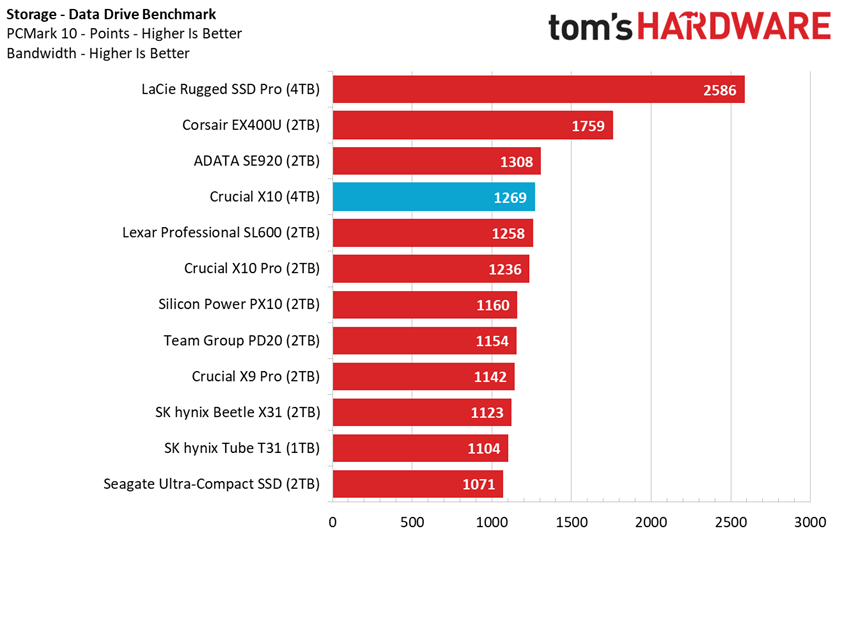
In this first test, the Corsair X10 was the fastest USB 3.2 Gen 2x2 drive we’ve tested, edging past the previous-gen X10 Pro and Lexar’s SL600 drive. The early USB4 drive from ADATA (the SE920) also wasn’t much faster here. But of course, the recent USB4 Corsair drive and the Thunderbolt 5 drive from LaCie land on top, where they will stay for most of these tests.
Get Tom's Hardware's best news and in-depth reviews, straight to your inbox.
Transfer Rates – DiskBench
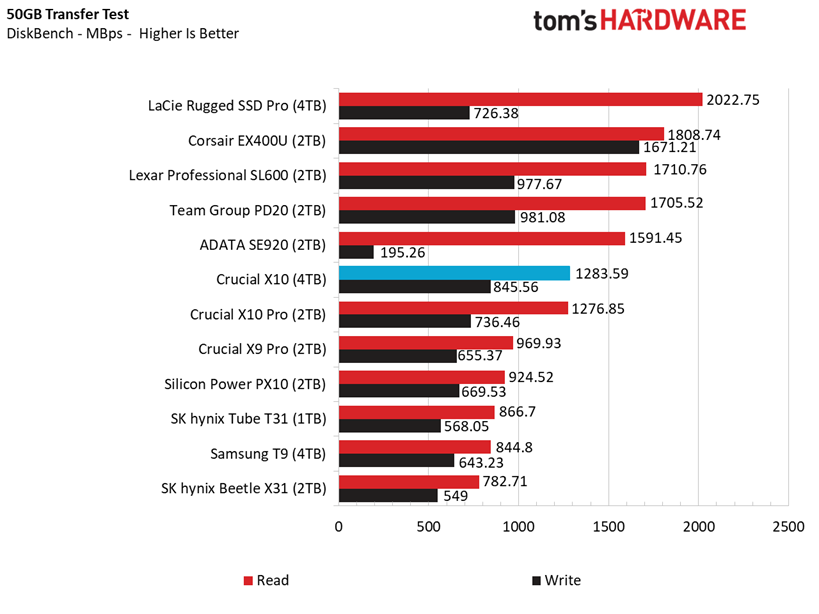
In this real-world file transfer, the Corsair and LaCie are again the fastest, followed by the 20 Gbps Lexar and Team Group drives. While the Crucial X10 lands close to the middle on this test, its read and write speeds are again better than the older Crucial drives, and well balanced, unlike the Adata, which was extremely slow on writes.
Synthetic Testing CrystalDiskMark
CrystalDiskMark (CDM) is a free and easy-to-run storage benchmarking tool that SSD companies commonly use to assign product performance specifications. It gives us insight into how each device handles different file sizes. We run this test at its default settings.

In this best-case synthetic sequential scenario on our recently overhauled testbed, the Crucial X10 loses out slightly to the Team Group PD20 on read speeds, but easily beats it and the Lexar drive on writes, getting very close to 2 GBps.
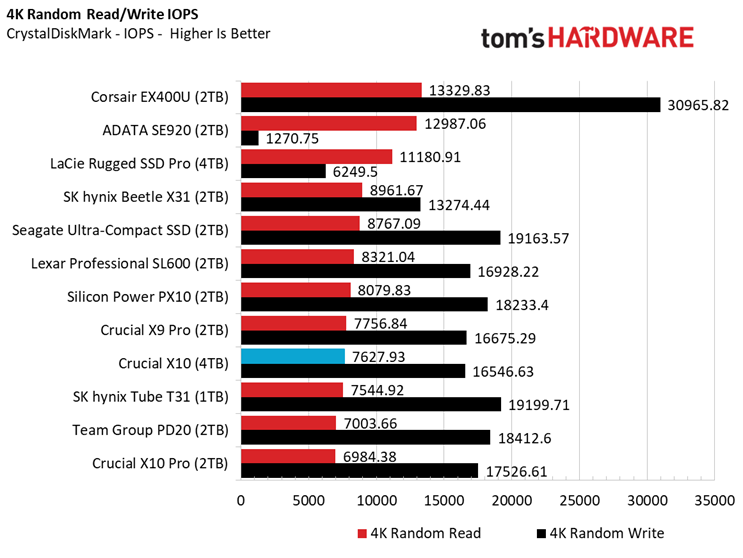
Small file performance was the one area where the older X10 Pro didn’t excel, and while the new X10 does better on reads, it falls behind the lower-end X9 in our testing, and is in the lower half of our comparison chart on both reads and writes. Still, its performance is generally in the range of its 20 Gbps competition.
Sustained Write Performance
A drive's rated write specifications are only a piece of the performance picture. Most external SSDs (just like their internal counterparts) implement a write cache, or a fast area of flash, programmed to perform like faster SLC, that absorbs incoming data.
Sustained write speeds often suffer tremendously when the workload saturates the cache and slips into the "native" TLC or QLC flash. We use Iometer to hammer the SSD with sequential writes for 15 minutes to measure the size of the write cache and performance after the cache is saturated.
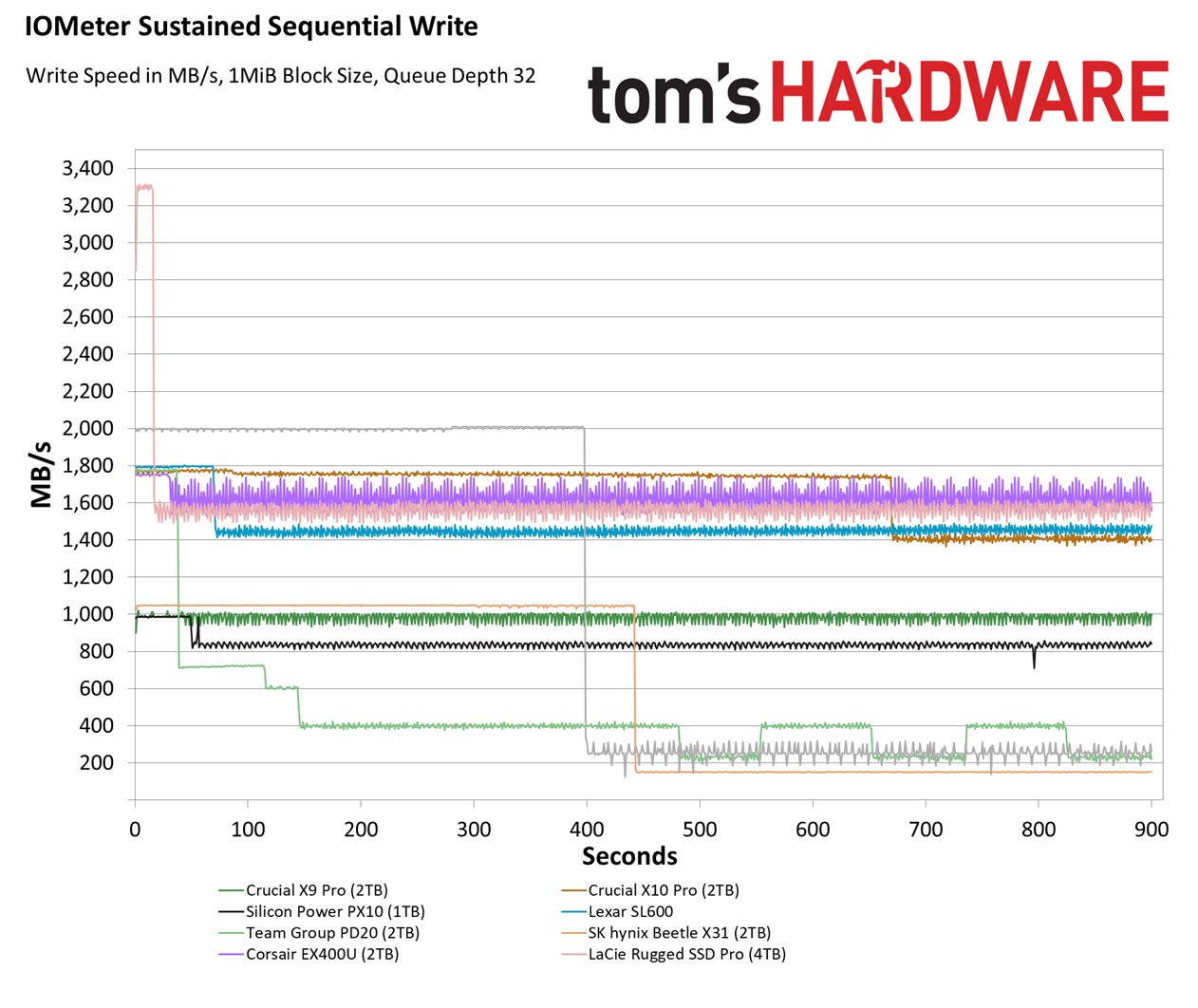
The Crucial X10 starts well ahead of other 20 Gbps drives here, hovering just under 2000 MBps, and it stays in that range for about six minutes and 40 seconds. That’s enough time to move about 800GB of data at the top end of the 3.2 Gen 2x2 bus, but then the drive crashes into the 200-300 MBps range, where it stays for the rest of our testing run.
Based on this, we wouldn’t qualify the X10 as a professional drive for those who need to fill up the entire drive quickly (and to be fair, neither does Crucial). But it’s still plenty fast for several minutes of constant writes, and faster than LaCie’s Thunderbolt 5 drive and Corsair’s USB4 SSD for a good chunk of this chart. For writing data sets smaller than about 1TB, the X10’s performance is solid.
Bottom line
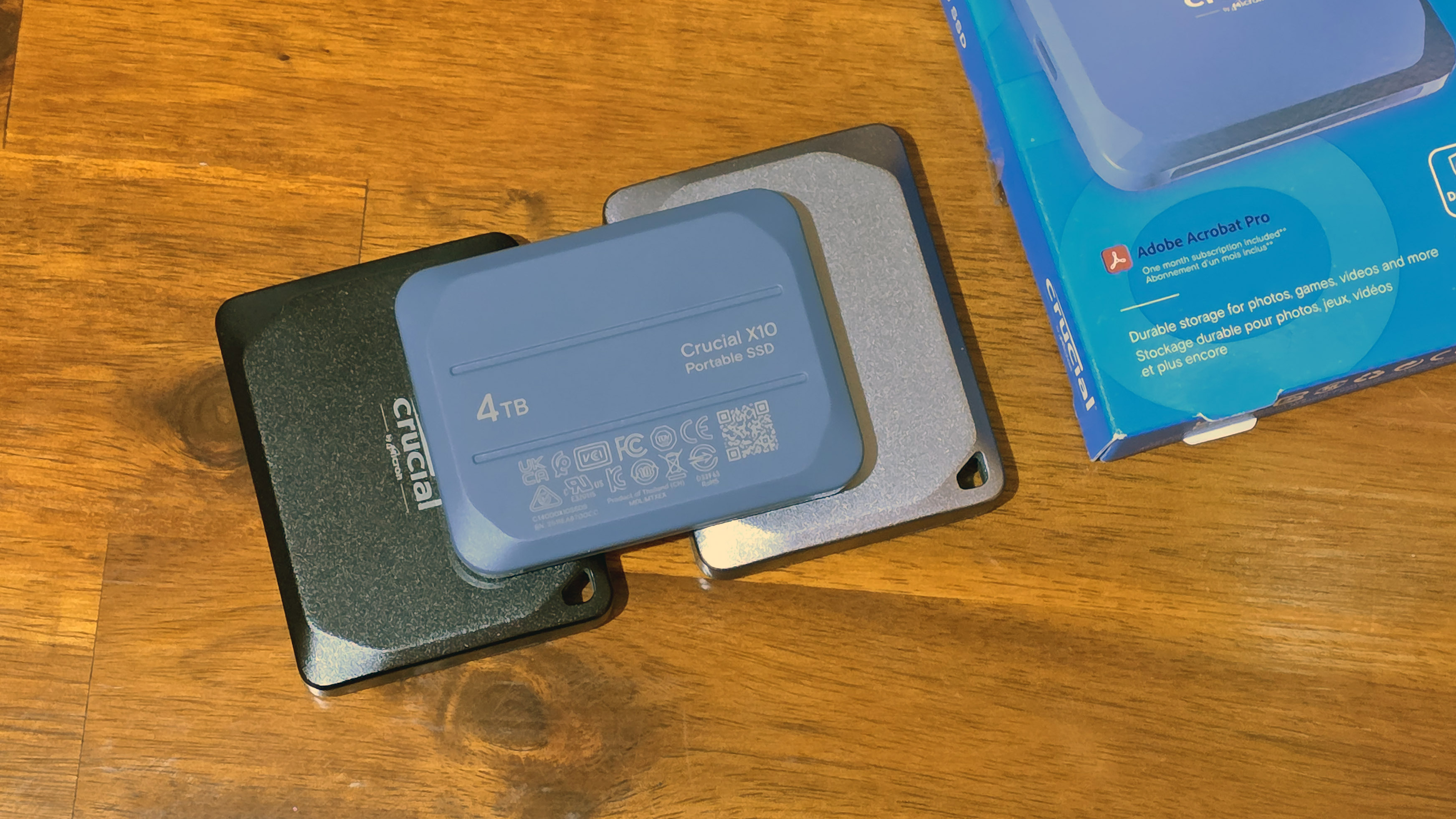
With very good 20 Gbps performance, lots of capacity options, and a tiny, rugged-feeling IP65-rated shell, Crucial’s X10 is one of the best USB 3.2 Gen 2x2 drives you can buy, and should be especially appealing to those looking for a 6TB or 8TB option.
That said, USB 3.2 Gen 2x2 ports were never particularly popular, and faster USB4 and Thunderbolt 4 ports seem to already be much more common. If your system has one of those newer, speedier ports, or you just want a drive that’s more forward-looking, Corsair’s EX400U is much faster in most of our tests and is currently $5 cheaper at 1TB and $27 more expensive at 2TB. Step up to 4TB, though, and the Corsair USB4 drive is a tougher sell, as it costs $73 more than Crucial’s tiny X10.
MORE: Best SSDs
MORE: Best External SSDs
MORE: Best SSD for the Steam Deck
After a rough start with the Mattel Aquarius as a child, Matt built his first PC in the late 1990s and ventured into mild PC modding in the early 2000s. He’s spent the last 15 years covering emerging technology for Smithsonian, Popular Science, and Consumer Reports, while testing components and PCs for Computer Shopper, PCMag and Digital Trends.
-
cia1413 I didn't see it in the article, but my experience is that usb 3.2 gen 2x2 drives only run at 10G speeds in usb4 and thunderbolt ports. Im sure there are some somewhere that run faster but every mac I have tried 2x2 drives on are only 10G and that really makes them 10G drives that might work at 20G for someone else.Reply -
Extent8958 I thought I was going blind staring at the sustained write performance chart. As of 7/1/2025, the X10 is not even in the chart at all. Only the X10 Pro 2TB is included, which matches the described starting speed but not the cratering performance down to ~300MB/s. Please update the chart to actually include the reviewed drive.Reply
https://cdn.mos.cms.futurecdn.net/Mot8KijGSgsuYfrgaDvMwC-1200-80.png.webp -
Extent8958 Reply
Thunderbolt 4 doesn't support a USB 3.2 Gen 2x2 (20Gbps) mode. It falls back to 10Gbps. So yes, Thunderbolt 4 devices will only get half the maximum performance out of this drive. USB4 has a 20Gbps mode, but AFAIK the signaling is different than USB 3.2 Gen 2x2, so isn't guaranteed to work (unless the host controller has done something special to support it).cia1413 said:I didn't see it in the article, but my experience is that usb 3.2 gen 2x2 drives only run at 10G speeds in usb4 and thunderbolt ports. Im sure there are some somewhere that run faster but every mac I have tried 2x2 drives on are only 10G and that really makes them 10G drives that might work at 20G for someone else.
The great thing about these kinds of drives is that they are absurdly tiny compared to a 2280 M.2 NVMe drive in a beefy enclosure. But for maximum performance, and flexibility to reach maximum performance with a given machine, you are way better off with a decent USB4 M.2 enclosure and a decent 2280 M.2 NVMe drive to stick in it.

